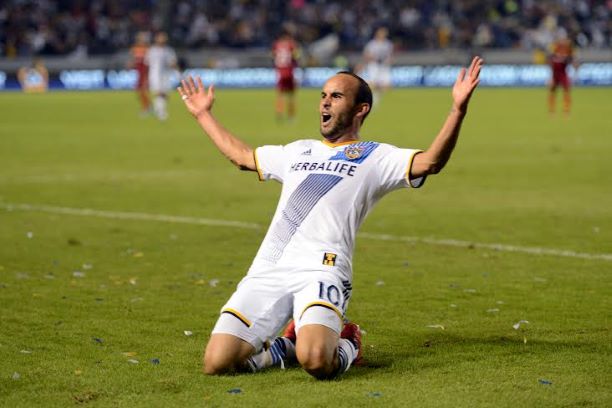Beyond packed stadiums, there is a Forest Pitch
Beyond packed stadiums, there is a Forest Pitch
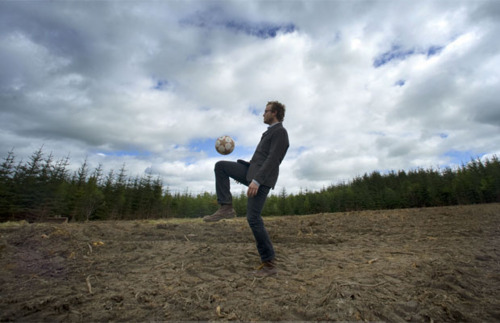

Interview with artist Craig Coulthard, the mind behind Forest Pitch, an event that will be part of the London 2012 Festival and Cultural Olympiad. Conducted by Eric Beard.
Succinct Briefing About Forest Pitch: A full size football pitch hidden deep within a commercial forest in the Scottish Borders. Trees that have been felled to make space for the pitch are being used to create goalposts, a shelter and other infrastructure on site, and the pitch is being made using recycled top soil from a local football ground. The heart of Forest Pitch is a day of sporting and cultural events that encapsulates the spirit of the modern Olympic movement. On the 21st of July, two amateur football matches (one between male teams and one between female teams) will be played on the pitch, complemented by a range of performances by local groups.
Craig Coulthard: I guess like a lot of ideas, Forest Pitch was gradually revealed to me as different things I was interested in, and had experienced came together at the right time. The main roots of the idea spring from my childhood experience of playing football for a local team in what was then West Germany, deep in the middle of a wood, with a small changing room and a chapel nearby. Later, I played football at Cathkin Park in Glasgow, which was once Third Lanark’s ground. Now, as when I played there, the ground has large tall trees growing straight from the terracing. When I was 15 playing there, it was quite dream like and disconcerting. Later still, I had been travelling by plane from London to Edinburgh, and flew over the Borders. I was looking down at all the forestry, with its small tracks seemingly leading nowhere, and I was struck by how exciting it would be to come across a football pitch there, either walking to it, or seeing it from the sky.
Around the point at which I started thinking about this, there was a call for proposals for “Artists taking the lead” on the Scottish Arts Councils website – asking for “big ideas” which could integrate some of the aims of the Olympics into an artwork. The application had to be around 300 words, so I sent mine in, pretty much “a football pitch in a forest, trees cut down are used for goalposts and a changing room. Two games are played on the pitch, then it is left to grow back naturally” – after that, I was shortlisted, and then had a couple of months to put a full proposal together, then do a short presentation to the panel organized by the Arts Council (now Creative Scotland) – I really didn’t think I would be awarded the commission, but in October 2009 I found that I had. The idea in itself was something I felt I would always want to do, but would never have the opportunity to create. I’m grateful to be given the chance!
Eric: What was the process in turning this concept into a reality?
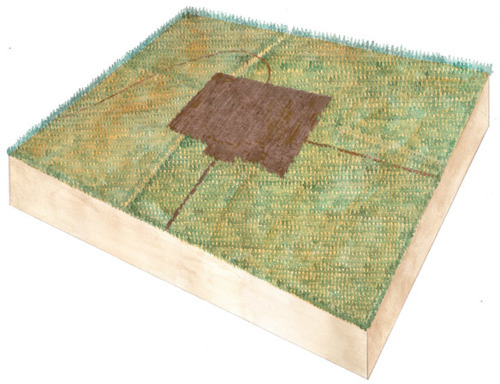
Craig: As I say above – once I had written in the 300 word proposal, and found I had been shortlisted, I had a couple of months to tighten up the idea. That is when I started to get help from my now project manager, and seeking some advice from other artist friends etc. At this point, more ideas started to flesh out the initial idea, the players that would take part, the ideal site for the work, how strips would be designed etc. I then put this proposal into a book form, had it nicely printed on recycled paper, bound like a library volume. At that point, I thought it was worth creating something worthwhile in itself (the book) as I didn’t think I would get the commission, so it would be good to have something well made to look back on.
After being awarded the commission, we had already established a schedule of works, budgets etc – the first big thing was finding a suitable site – that took over a year! Also, I began to make more contacts with knowledgeable people, as there are a whole host of elements to this project that I am far from an expert on.
EB: The pitch will be hidden within a forest, only visible from a bird’s eye view. Is this meant to provide a sense of seclusion and separation from the outside world?
CC: The pitch will be visible on foot as well! I should hasten to add, as there have been a number of misunderstandings regarding the visibility of the site. Other than actually being at the site, yes, the pitch will only be seen from the sky. It is about creating seclusion, isolation, and a certain amount of concentration – a commitment to what you will see before you. I was referencing my own experience of woodland football too, but this pitch will be a lot closer to the trees, and therefore will be slightly claustrophobic. I want people to be close to the football, but also close to the environment around them. Being so secluded, and unseen will also add to the excitement of viewing the game I hope. I wanted to create almost a sacred grove. The centre of a spruce forest is also somewhere that is rarely accessed, because of the nature of spruce and how it is planted, they are so dense and dark to be almost impenetrable. The contrast between close darkness, and open space on approach to the pitch will be great, and I thereby hope to reveal the pitch, like the opening of a theatre curtain.
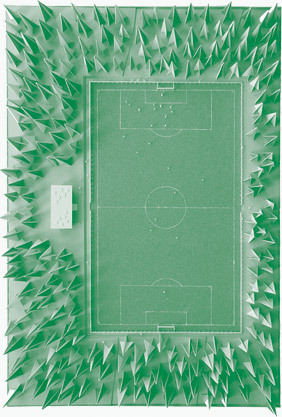
EB: You even go a step further, saying that playing in a forest provides a memorable and magical experience. What kind of magic is revealed in this environment?
CC: I think forests hold a very special mystique to us as humans. They can be magical, dreamlike, nightmarish – full of fairies, spirits and the like, as well as being host to some of the worst horrors imaginable. From the Curupira of Brazilian Tupi mythology, to the Brothers Grimm. From the destruction of habitats to the destruction of human beings. That said, the “nature” of this site, and many others like it, is that it is a crop. Trees are capable of having a strong emotional tie over people – perhaps almost a blinding spell, after all, you cannot see the wood for the trees. Forest Pitch specifically will hopefully reveal the magic of human participation, as well as human variety. Perhaps it will lift a blindfold to help reveal the true nature of Scotland, and further afield. Lastly, of course is the magic of football itself, the way it can hold people, almost trance-like, both spectators and participants. One of the great things about football is that it can be played anywhere, so people say. Even in a forest.
EB: As part of the London 2012 Festival, will media be covering the Forest Pitch matches? Will there be restrictions to ensure cameras and microphones don’t steal the allure of the event?
CC: This is an important point. There will be some documenting of the games, overseen by myself. We are planning to broadcast a commentary online, but I won’t be streaming images of the game live. I am also keen to encourage people not to film the event, or bring cameras. The idea being that people will concentrate fully on what is around them, without recording it for the future. I want spectators, and players, to have to use their imagination to recall the events. People who are unable to attend, will be able to view the images we create, the sounds we record, as well as listening online – but I am keen to ensure that there is always a missing piece of the jigsaw, that people have to use their imagination and memory to complete.
EB: You mention that this project is a celebration of national identity. There are many places where I could see something like happening (Portland and Berlin immediately come to mind), but what makes Forest Pitch fitting for Scotland?

CC: I am keen for Forest Pitch to raise questions about national identity, what it is, how it’s defined, if it’s important and why. This can be viewed alongside debate about national football teams, the Olympics, native species of trees etc. In the modern world I think this project would be relevant in most countries. Scotland is the place I view as home, and I have my own thoughts about my own national identity, I am sure most people across the world have theirs. We live in an age where the nation state is generally, but not always, a defining feature of societies. What makes it interesting in Scotland is the relationship between Scottish national identity, British identity, European identity, etc. No one is born with a Scottish passport…
EB: I know if I found myself in Scotland next summer then I’d be keen to partake in a match on Forest Pitch, but have any professionals or celebrities shown interest in supporting the project?
CC: Not as yet – re professionals, the idea is that all of the players will be amateurs, as at the beginning of the modern Olympics. We do have interest from a women’s international player though, which is very exciting. Celebrities are as welcome as anyone!
EB: The two amateur matches taking place on Forest Pitch on July 21st 2012 are only open to people that have held British citizenship since the year 2000 (so my dream of playing remains a dream). What was the main thought process behind this decision?
CC: One of the official themes of the Cultural Olympiad is to ‘Celebrate London and the UK welcoming the World’. By celebrating the diversity of Scottish communities through recent citizens we hope to “welcome the world”. Sport (in this case, football) can function as a very effective way of bringing people together, regardless of background, race, language or religion.
Forest Pitch aims to provide a chance for people who are often overlooked, to have the opportunity to be involved in a major cultural/sporting event. I am aware through my own experiences, that football can bring people together. Forest Pitch will attempt to reflect the Olympics itself, by bringing people together from many different parts of the world, while also investigating what it means to be British.
I also thought that it would be interesting to have people participate who have made a decision (sometimes forced) to become British.
EB: With capitalism and greed seeping into football from all angles, economic sustainability does not seem a priority. Is Forest Pitch, in part, a statement against the way modern football, or even modern sport as a whole is progressing?
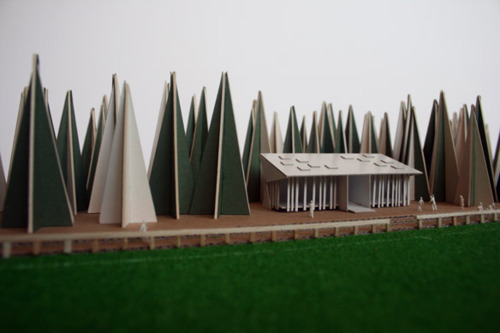
CC: In some ways. It should be remembered that this project also costs money. I did want to ensure that the participants in the games were playing because they love it, not because its their profession. What is happening generally in football is that clubs are looking for short term gains, without generally considering the long term implications of their risk taking. This is comparable to the way much of the world approaches environmental concerns. Another element of the magic of football, as far as I’m concerned, is that if all the major clubs went tits up, and had to close their stadiums, lay off the players, no more football on TV – the truth is, people would still go out and play – people would support the teams that played near them, or had friends in, new places to play would be established. The game won’t go away, because it is so addictively simple, and fun, and varied. Ok, the quality would not be as good perhaps, but the closeness to the game would increase. I think the example of the relative success of AFC Wimbledon and FC United in England are illustrations of that potential.
When clubs in Britain were first established, they were school chums, or working men, there was a sense of belonging. It’s been said so many times before, but it is hard to relate to travelling millionaires – especially when, even highly likeable characters (Asamoah Gyan) are tempted to go elsewhere so easily, for what appears to be for no other reason than to fill their already overflowing wallets. Forest Pitch is about celebrating the ability of the sport to bring people from all over the place together, it’s a cliché, but we all speak the same language on the pitch. I know from my own experience, if you go to an unfamiliar place, you can almost immediately establish a relationship of some sort with strangers, by playing, or watching football.
EB: After the matches, native species, such as ash and oak, will be planted along the markings of the pitch, and also positioned to signify players’ formations commonly associated with the game. What formation are we going with? 4-4-2? Scotland’s new 4-6-0?
CC: Ah, the 4-6-0. Scotland invented the game, and continues to reinvent it…. Formation has not been decided yet, as you have to suit the game to the players you pick I feel. As the final line-up of trees hasn’t been decided, neither has the formation. We will have to consider the strengths and weaknesses of each tree, to decide where best it fits into the team….
EB: Some of Britain’s biggest and best (football) cities thrived off of industrialization back in the day. Do football clubs, such as Manchester City and Manchester United, have a responsibility to lead their city forward in sustainable, eco-friendly practices?
CC: Absolutely – I can’t comment on what either of those clubs’ environmental policies are though. I think responsibility lies with everyone, but everyone often needs those people/institutions they look up to to lead the way. These clubs though could retrospectively seem to have gained success and large and loyal followings because of the success of their city (though perhaps Sheffield would disagree…), which furthermore could be seen to have gained from the industrial revolution – and maybe now could contribute to the future of a sustainable city etc. But I wouldn’t enforce it more on football clubs than anyone else.
EB: As an artist, what do you see in the xenophobic and insensitive atmosphere amongst fans that often unleashes itself in places such as Wembley Stadium?
CC: I don’t necessarily view my opinions on xenophobia or intolerance in football as being shaped by my role as an artist. I experienced a turnaround in my own footballing interests when I was growing up as I began to fully understand some of the things which were being said at some of the games I attended. These expressions of intolerance did not sit easily with me, and I felt disengaged for a while. I don’t necessarily blame football for some of the things that surround it. Some people’s good atmosphere is another person’s nightmare and vice versa. Xenophobia should be discussed and exposed in all levels of society not just football. The nature of a large sporting event, with a certain amount of anonymity, mob mentality, a side to choose, as well as historic (footballing and otherwise) events and their effects, can create, unfortunately, the ‘ideal’ environment for people to spout things that otherwise they wouldn’t dare say (or even necessarily believe). There is the possibility of having rivalry, banter, respectful animosity between fans. I can’t begin to understand why someone would stab someone at a football match. I guess what I see in these kinds of atmospheres is the desire to belong. To be of one thing, and not the other thing. But why that manifests itself as violence and intolerance in some is a question that could be applied to all parts of society.
EB: Where do you think the essence of sport lies: in a stadium with 80,000 screaming fans or in a park (or forest)? Why?
CC: The essence, I believe, lies in the parks – where football began, and where it continues to be played by the majority of players – without those, there would be no stadia. As I mentioned earlier, if the modern professional game all came tumbling down, there would still be grass, there would still be a ball, there would still be players trying to express themselves, there would still be different colours of fabric to be worn.
You can follow Forest Pitch on Twitter @ForestPitch and find all the information you could possibly want at forestpitch.org





